Астана, 2014
Министерство образования и науки Республики Казахстан
Евразийский национальный университет им. Л.Н. Гумилева
Физико-технический факультет
Кафедра «Технической физики»
ОТЧЕТ МАГИСТРАНТА О ПРОХОЖДЕНИИ НАУЧНО-ИССЛЕДОВАТЕЛЬСКОЙ ПРАКТИКИ.
Техническая физика - 6M072300
(Научно-педагогическое направление)
Исполнитель:магистрант 2 курса Туркумбаев Ж.Ж. /______________/
(Ф.И.О) (подпись)
Научный руководитель:
к.ф-м.н.
(уч. степень, уч. звание, должность)
Қайңарбай А.Ж. /____________/
(Ф.И.О) (подпись)
Заведующий кафедры:
д.ф-м.н., профессор
(уч. степень, уч. звание, должность)
Тлеукенов С.К. /____________/
(Ф.И.О) (подпись)
Астана, 2014
Thesis: automation of the experimental setup for vacuum-ultraviolet spectroscopy.
Objective: the automation of the experimental setup for vacuum-ultraviolet spectroscopy.
The aim of the work:
- Literature review on the research topic
- Learn stepper motors
- Development of a controller for controlling sm
- Selection control program sm
- Alignment and calibration VM
- Obtaining spectra in the VUV region known for crystals
Scientific novelty of the research: Obtaining spectra for crystals in the VUV region.
Practical and theoretical value: unit will allow to carry out experimental research in the framework of research projects and laboratory works.
In the library and electronic database of the faculty were studied materials and specialized literature on the topic of the thesis:
1. V.T. Astrelin, A. V. Burdakov, P.Z. Chebotarev, V.V. Filippov, V.S. Koidan, K.I. Mekler, P.I. Melnikov, V. V. Postupaev, A. F. Rovenskikh, M.A. Shcheglov Hot electron target interaction experiments at the GOL – 3 facility. // Nuclear fusion, Vol. 37, No 11 (1997), p. 1541 - 1558.
2. S. V. Polosatkin, A. V. Burdakov, V. Piffl, V. V. Postupaev, and Vl. Weinzettl. Investigation of impurity dynamics at GOL-3 facility // Fusion Science and Technol-ogy. – 2005.-V.47. – N.1T. - P.267.
3. V. Piffl, Vl. Weinzettl, A. Burdakov, S. Polosatkin Intensity radial profiles of VUV lines near the carbon target in the CASTOR tokamak. // 31st EPS Conference on Plasma Phys. London, 28 June - 2 July 2004 ECA Vol. 28B, P-5.138 (2004).
4. V. Piffl, A. Burdakov, N. Korneva, S. Polosatkin, Vl. Weinzettl Measurement of line radiation power in the CASTOR tokamak. // 33rd EPS Conference on Plasma Phys. Rome, 19 - 23 June 2006 ECA Vol. 30I, P-2.196 (2006).
5. Kelly J.J., Callis J.B. Nondestructive Analytical Procedure for Simultaneous Estimation of the Major Classes of
Hydrocarbon Constituents of Finished Gasolines // Anal. Chem. 1990. V. 62.
6. Wayer L.G. Near-Infrared Spectrometry of Organic Substances // Appl. Spectroscopy Reviews. 1985. V.21.
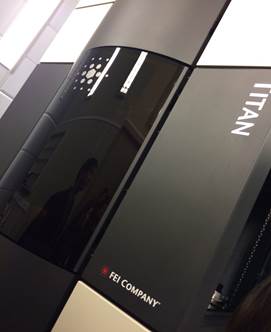 In the laboratory studied foreign literature concerning the topic of research. The main directions of development studies at the physics Department of the University of Antwerp is connected with electron microscopy.
In the laboratory studied foreign literature concerning the topic of research. The main directions of development studies at the physics Department of the University of Antwerp is connected with electron microscopy.
The most preferred scanning/transmission electron microscope (S/TEM) among leading scientists around the world is the Titan design (figure 1). Since its inception in 2005, excellent design Titan and have proven ability to provide innovative results.
Fig.1. Electron microscope Titan
Family FEI Titan ™ /TEM includes the most powerful in the world, a commercially available S/TEM: Titan™ G2 60-300, Titan3™ G2 60-300, Titan Krios™ and Titan™ ETEM (environmental TEM). Created on the basis of revolutionary 60-300 kV electron column, all Titan s enable research at the level of sub Angstrom, to make discoveries at the atomic level and to work in TEM stem modes with a wide range of materials and in different operating conditions.


Titan is the first and only S/ TEM, designed to fully achieve the corrected S/TEM. Correction of aberrations beyond the fundamental optical limitations of magnetic lenses, but requires an equally fundamental changes in the system design to achieve the stability required for ultra high resolution and analysis. Extra wide geyser Titan and was specially designed to give mechanical stability required in connection with the additional weight of the probe and the offsets of the image. His own lens constant power and advanced power supplies provide the necessary thermal and electronic stability.
return false">ссылка скрытаProfessor Milorad Milosevic was conducted lectures on familiarizing us with directions of research scientists at the physical faculty of the University of Antwerp and in subsequent lectures research were covered in more detail (figure 2)

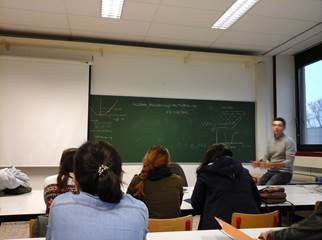
Figure 2. Lectures of Professor Milorad Milosevic.
Lectures were held in the form of a dialogue, resulting alive and mutually beneficial. When visiting the laboratory was able to spend a couple of experiments on the high-class equipment.
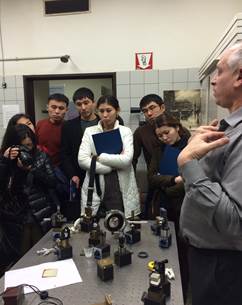
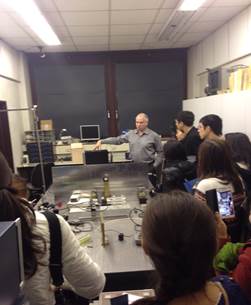
Was studied literature and scientific articles, electronic databases in the field of vacuum-ultraviolet spectroscopy (figure 3)


Figure 3. Independent work in the library and classroom.
Also a meeting was held with Dr. Artem Abakumov in which were discussed the problems of research of the vacuum ultraviolet region.
On the research topic with the help of the laboratory experiments were reflected in the existing accumulated information on the topic (figure 4).
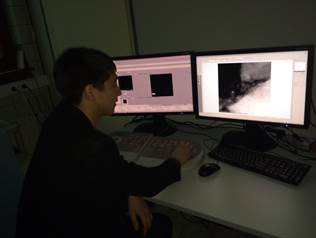
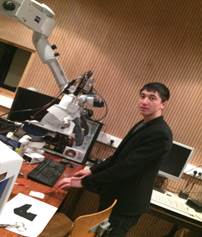
Figure 4.Conducting experiments.
In casinoit were studied absorption spectra of hydrocarbons obtained using spectrophotometric system laboratory. Research has helped to clarify the position of the main absorption bands in their spectra.
As the basis for creating a spectrophotometric system was selected monochromator MDR-41. Its optical blocks allow you to create a thoroughly modern experimental setup. It is also possible to place on the optical rail wide range of optical components and with minimal effort to replace used in the experiment light sources, photometric head and electronic components. This design spectrophotometric system has the highest potential for modernization.
As test objects of study for tests spectrophotometric complex were selected isooctane n-heptane. This choice is due to the fact that their absorption spectra in the region of the first overtones of the hydrocarbon groups CH3 and CH2 are well known and differ from each other in intensity of the bands due to different numbers of these groups in their molecular formulas.
Measurement of the absorption coefficient k was carried out with respect to the air when the thickness of the hydrocarbon layer 1 mm Width of the entrance slit of the monochromator was 0.1 mm, and the output - 2.5 mm were First recorded signal when it is installed on the beam path empty cell, then the cell is filled the hydrocarbon. The results of these measurements was calculated according to k = f (λ) for isooctane and n-heptane (Fig. 5).

Fig. 5. Dependence of the absorption coefficient k of wavelength λ for isooctane (curve 1) and for n-heptane (curve 2)
The analysis presented in Fig. 5 the absorption spectrum of isooctane (curve 1) shows that it contains two strongly overlapping intensive bands of CH3 groups with maxima at λ = 1695 and 1705 nm, which agrees well with the data works. The band maxima of the CH2 groups in the spectrum of isooctane at λ = 1722 and 1770 nm is less pronounced, but they are well types in the spectrum of n-heptane (curve 2) with maxima at λ= 1723 and 1762 nm, which is caused by the difference in the number of CH2 groups in the molecular formulas of isooctane and n-heptane (1 and 5 respectively). At the same time in the absorption spectrum of n-heptane compared tooups in the molecular formulas of isooctane and n-heptane (1 and 5 respectively). At the same time in the absorption spectrum of n-heptane compared to isooctane significantly weaker bands of CH3 groups that are associated with a decrease in the number of these groups from 5 to 2. While the band maxima are slightly shifted (λ = 1693 1703 and nm).
Was given a high evaluation of laboratory research Institute of new materials, Department of technical physics of the L.N. Gumilyev ENU.
Conclusion:
Based on the research work carried out in the Antwerp University, you can make the following conclusions:
- collected materials on master's thesis in the University library;
- the results of observations in the vacuum ultraviolet region;
- consulted a doctor from the University of Antwerp Artem Abakumov.
Supervisor Kainarbay A.Zh.
Undergraduate Turkumbayev Zh. Zh.